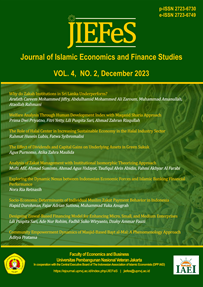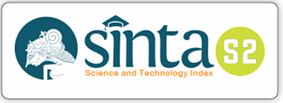The Effect of Dividends and Capital Gains on Underlying Assets in Green Sukuk
DOI:
https://doi.org/10.47700/jiefes.v4i2.6473Keywords:
Capital Gains, Dividend Policy, Retail Sukuk, Underlying AssetsAbstract
Underlying assets are one of the required instruments for issuing sukuk to attract investors to invest in the Sharia capital market. Green sukuk is one of the sharia investment instruments issued by companies for retail sukuk products and has the aim of obtaining funding through debt securities or securities to encourage the company's growth and development performance through underlying assets. This research aims to determine the effect of dividends and capital gains on the underlying assets in retail sukuk. This research method uses a quantitative method with a descriptive approach. In collecting data, the random sampling method was used, where the research determined the number of samples using the Slovin method to know the number of samples and determine the sample categories for distributing questionnaires. The results of dividend research do have a significant influence on underlying assets. Based on the graph, dividend distribution has increased every year, thereby influencing the growth performance of underlying assets. A company will be said to be good if the income it earns is greater than its expenses, so it affects the company's assets. While capital gains also have a significant effect on the underlying assets in retail sukuk, it does not rule out the possibility that they will be influenced by other factors that are related to capital gains.
Underlying aset merupakan salah satu instrumen yang diperlukan dalam penerbitan sukuk untuk menarik minat investor berinvestasi di pasar modal syariah. Green sukuk merupakan salah satu instrumen investasi syariah yang diterbitkan perusahaan untuk produk sukuk ritel dan bertujuan untuk memperoleh pendanaan melalui surat utang atau surat berharga untuk mendorong pertumbuhan dan perkembangan kinerja perusahaan melalui aset yang mendasarinya. Penelitian ini bertujuan untuk mengetahui pengaruh dividen dan capital gain terhadap underlying asset pada sukuk ritel. Metode penelitian ini menggunakan metode kuantitatif dengan pendekatan deskriptif. Dalam pengumpulan data digunakan metode random sampling, dimana penelitian menentukan jumlah sampel dengan menggunakan metode Slovin untuk mengetahui jumlah sampel dan menentukan kategori sampel untuk penyebaran kuesioner. Hasil penelitian dividen memang mempunyai pengaruh yang signifikan terhadap aset dasar. Berdasarkan grafik, pembagian dividen mengalami peningkatan setiap tahunnya sehingga mempengaruhi kinerja pertumbuhan aset dasar. Suatu perusahaan akan dikatakan baik apabila pendapatan yang diperoleh lebih besar dibandingkan dengan pengeluarannya, sehingga mempengaruhi kekayaan perusahaan. Meskipun capital gain juga berpengaruh signifikan terhadap aset dasar sukuk ritel, namun tidak menutup kemungkinan hal tersebut akan dipengaruhi oleh faktor lain yang terkait dengan capital gain.
References
Agustianti, R., Pandriadi, Nussifera, L., Wahyudi, Angelianawati, L., Meliana, I., Sidik, E. A., Nurlaila, Q., Simarmata, N., Himawan, I. S., Pawan, E., Ikhram, F., Andriani, A. D., Ratnadewi, & Hardika, I. R. (2022). Metode Penelitian Kuantitatif Dan Kualitatif. TOHAR MEDIA.
ALFINA, S. (2022). ANALISIS PENGARUH ENVIRONMENTAL PERFORMANCE DAN TATA KELOLA TERHADAP PROFITABILITAS DALAM PERSPEKTIF MAQASHID SYARIAH (Studi Pada Perusahaan Tambang yang Terdaftar di Jakarta Islamic Index Periode 2018-2020) [Diploma, UIN RADEN INTAN LAMPUNG]. http://repository.radenintan.ac.id/20016/
Ali Darar, M. (2021). İslami Sermaye Piyasası ;gelişmeler ve zorluklar [Thesis]. http://acikerisim.karabuk.edu.tr:8080/xmlui/handle/123456789/1305
Alkamal, M. (2021). An Exploratory Study of Optimal Financing and Funding Schemes to Support Financial Feasibility of Waste-to-Energy Project in Indonesia [Skripsi, Politeknik Keuangan Negara STAN]. http://eprints.pknstan.ac.id/1384/
BAKRI, M. H., ISMAIL, S., AL-SHAMI, S., ZAINAL, N., & RIDZUAN, A. R. (2020). Modeling an Islamic Student Financing Securitization. The Journal of Asian Finance, Economics and Business, 7(10), 1047–1056. https://doi.org/10.13106/JAFEB.2020.VOL7.NO10.1047
Chien, J. (2021). Financing gender empowering green growth in Indonesia [Report]. Impact Investment Exchange. https://cgspace.cgiar.org/handle/10568/114453
El-Karanshawy, D. H. A., Omar, D. A., Khan, D. T., Ali, D. S. S., Izhar, D. H., Tariq, W., Ginena, K., & Quradaghi, B. A. (n.d.). Ethics, Governance and Regulation in Islamic Finance.
Endri, E., Hania, B. T., & Ma’ruf, A. (2022). Corporate green Sukuk issuance for sustainable financing in Indonesia. Environmental Economics, 13(1), 38–49. https://doi.org/10.21511/ee.13(1).2022.04
Grahesti, A., Nafii"ah, D. F., & Pramuningtyas, E. (2022). Green Sukuk: Investasi Hijau Berbasis Syariah Dalam Mewujudkan Ketahanan Terhadap Perubahan Iklim Di Indonesia. Jurnal Ilmiah Ekonomi Islam, 8(3), Article 3. https://doi.org/10.29040/jiei.v8i3.6443
Güçlü, F. (n.d.). 15 The Rise of Environmental Consciousness in Islamic Finance: Green Sukuk.
Hania, B. T., Endri, E., & Indra, I. (2022). Identify the Issuance Problem of Corporate Green Sukuk in Indonesia. Islamic Economics Journal, 8(2), Article 2. https://doi.org/10.21111/iej.v8i2.8404
Ibnu, D. S. P., & Lubis, A. W. (2022). Determinants of Sukuk Issuance with Mediating Role of Effective Tax Rate. 71–77. https://doi.org/10.2991/aebmr.k.220304.010
Khnifer, M. (2010). When Sukuk Default – Asset Priority of Certificate-Holders Vis a Vis Creditors (SSRN Scholarly Paper 1712058). https://doi.org/10.2139/ssrn.1712058
Luqman, S., Lasniroha, T., Fadjar, A., Rusmawan, R. W., Veronica, V., Gedizza, G., & Zakiah, Z. (2022). The Effect of Capital Market Career Socialization and Financial Management Knowledge on Accounting Students’ Interests in Capital Market Careers. The International Journal of Business Review (The Jobs Review), 5(2), Article 2. https://doi.org/10.17509/tjr.v5i2.51136
Maulida, A. Z., Noormailati, & Purnomo, A. (2023). Green Sukuk Retail Towards Sustainable Development in Indonesia. Islamic Economics Journal, 9(1), Article 1. https://doi.org/10.21111/iej.v9i1.9362
Maulida, A. Z., Noormailati, & Purnomo, A. (2023). Green Sukuk Retail Towards Sustainable Development in Indonesia. Islamic Economics Journal, 9(1), Article 1. https://doi.org/10.21111/iej.v9i1.9362
Maulida, A. Z., Risdiana, R., & Purnomo, A. (2023). Performance of Indonesia’s Sharia Capital Market for the 2022 Period. Journal of Islamic Economics and Philanthropy, 6(2), Article 2. https://doi.org/10.21111/jiep.v6i2.9369
Mseddi, S. (2023). International issuance of Sukuk and companies’ systematic risk: An empirical study. Borsa Istanbul Review, 23(3), 550–579. https://doi.org/10.1016/j.bir.2022.12.007
M.t, L., & S, N. (2021). Impact of Covid-19 on Developments of Bioenergy in Malaysia and Digital Financing for Post Pandemic Recovery. Asian Journal of Research in Business and Management, 3(2), Article 2.
Mulyadi, S., & Wibowo, M. G. (2023). The Influence and Contribution of Macroeconomics to The Indonesian Sharia Stock Index for The Period 2011-2021. Journal of Islamic Economic Laws, 6(1), Article 1. https://doi.org/10.23917/jisel.v6i1.21073
Munir, S., Masruro, U., Fawaiq, A., & Merlinda, S. (2020). GREEN SUKUK: INDONESIAN YOUTH INVESTMENT PROSPECTS FOR ENVIRONMENTAL SUSTAINABILITY. Economics Business and Organization Research, 140–147.
Musari, K. (2022). ASEAN Toward Circular Economy and Sustainable Energy in Tackling Climate Change: Islamic Green Financing Taxonomy for Sustainable Finance. In Handbook of Research on Building Greener Economics and Adopting Digital Tools in the Era of Climate Change (pp. 210–230). IGI Global. https://doi.org/10.4018/978-1-6684-4610-2.ch011
Nasreen, S., Naqvi, S. A. A., Tiwari, A. K., Hammoudeh, S., & Shah, S. A. R. (2020). A Wavelet-Based Analysis of the Co-Movement between Sukuk Bonds and Shariah Stock Indices in the GCC Region: Implications for Risk Diversification. Journal of Risk and Financial Management, 13(4), Article 4. https://doi.org/10.3390/jrfm13040063
Noor, N. S., Rahim, R. T. A., & Safiee, A. (2020). To Fish in Trouble Water: Ar Rahnu during Covid-19 Pandemic. 4(1).
Ns Erna Febriyanti, S. Kep MAN et al. (2022). Metodologi Penelitian Kuantitatif dan Kualitatif. Media Sains Indonesia.
Purnomo, A., & Maulida, A. Z. (2023). BANK INFAQ: RISK MANAGEMENT IN THE PROVISION OF UMKM CAPITAL DURING COVID-19. Al-Infaq: Jurnal Ekonomi Islam, 14(1), Article 1. https://doi.org/10.32507/ajei.v14i1.1824
Purnomo, A., Maulida, A. Z., Tuzahra, S. F., & Lestari, D. A. (2023). Bank Indonesia Syariah Certificate: Encouraging Economic Growth During The COVID-19 Pandemic. JURNAL AL-QARDH, 8(1), Article 1. https://doi.org/10.23971/jaq.v8i1.5748
Purnomo, A., & Rusdiansyah, M. (2019). ANALISIS PRODUK TABUNGAN IB MUAMALAT PRIMA BISNIS TERHADAP SEKTOR RILL PEREKONOMIAN MASYARAKAT (STUDI KASUS PT. BANK MUAMALAT INDONESIA, TBK CABANG BANJARMASIN). NISBAH: Jurnal Perbankan Syariah, 4(2), 145–156.
Purnomo, A., & Zahra, A. (2022). Application and Implementation of ZIS Accounting Based on PSAK 109 at Amil Zakat Institutions (Case Study on Laznas BSM Ummah). Maqrizi: Journal of Economics and Islamic Economics, 2(1), Article 1. https://doi.org/10.30984/maqrizi.v2i1.214
Sairally, S., & Rassool, N. H. (2022). Prospects and Challenges for Islamic Investment and Wealth Management in Mauritius. In T. Azid, M. Mukhlisin, & O. Altwijry (Eds.), Wealth Management and Investment in Islamic Settings: Opportunities and Challenges (pp. 227–248). Springer Nature. https://doi.org/10.1007/978-981-19-3686-9_15
Scott Cato, M. (2022). What Puts the Sustainable into Sustainable Finance. In M. Scott Cato (Ed.), Sustainable Finance: Using the Power of Money to Change the World (pp. 17–37). Springer International Publishing. https://doi.org/10.1007/978-3-030-91578-0_2
Shahida, S., & Sapiyi, S. (2013). Why Do Firms Issue Sukuk Over Bonds? Malaysian Evidence.
Shubita, M. (2023). The relationship between return on investment and Jordanian banks value. Banks and Bank Systems, 18, 139–149. https://doi.org/10.21511/bbs.18(1).2023.12
Sial, M. S., Cherian, J., Meero, A., Salman, A., Abdul Rahman, A. A., Samad, S., & Negrut, C. V. (2022). Determining Financial Uncertainty through the Dynamics of Sukuk Bonds and Prices in Emerging Market Indices. Risks, 10(3), Article 3. https://doi.org/10.3390/risks10030061
Suwanan, A. F., Munir, S., & Merlinda, S. (2022). Analisis Analisis Peran dan Tantangan Sukuk Hijau Bagi Ketahanan Perubahan Iklim Pada Wilayah Rentan Selama Pandemi Covid-19. Al-Kharaj : Jurnal Ekonomi, Keuangan & Bisnis Syariah, 4(4), 978.
Suwanan, A. F., Munir, S., & Merlinda, S. (2022). Analisis Peran dan Tantangan Sukuk Hijau Bagi Ketahanan Perubahan Iklim Pada Wilayah Rentan Selama Pandemi Covid-19. Al-Kharaj : Jurnal Ekonomi, Keuangan & Bisnis Syariah, 4(4), Article 4. https://doi.org/10.47467/alkharaj.v4i4.767
Tang, D. Y., & Zhang, Y. (2020). Do shareholders benefit from green bonds? Journal of Corporate Finance, 61, 101427. https://doi.org/10.1016/j.jcorpfin.2018.12.001
Thaker, M. A. B. M. T., Khaliq, A. B., Thaker, H. B. M. T., Amin, M. F. B., & Pitchay, A. B. A. (2022). The Potential Role of Fintech and Digital Currency for Islamic Green Financing: Toward an Integrated Model. In F. Taghizadeh-Hesary & S. Hyun (Eds.), Green Digital Finance and Sustainable Development Goals (pp. 287–308). Springer Nature. https://doi.org/10.1007/978-981-19-2662-4_14
Tian, Y., Adriaens, P., Minchin, R. E., Chang, C., Lu, Z., & Qi, C. (2020). Asset Tokenization: A blockchain Solution to Financing Infrastructure in Emerging Markets and Developing Economies (SSRN Scholarly Paper 3837703). https://doi.org/10.2139/ssrn.3837703
TUTI, L. (2020). ANALISIS PERAN GREEN SUKUK DALAM MEMPERKOKOH KEUANGAN SYARIAH DAN MENCIPTAKAN INDONESIA RAMAH LINGKUNGAN [Undergraduate, UIN Raden Intan Lampung]. http://repository.radenintan.ac.id/11880/
Ulfah, I. F. (2023). ANALISIS POTENSI PENERBITAN SUKUK DAERAH DALAM PEMBIAYAAN GREEN INFRASTRUCTURE DI DKI JAKARTA. Jurnal Syarikah : Jurnal Ekonomi Islam, 9(1), Article 1. https://doi.org/10.30997/jsei.v9i1.8511
Ulfah, I. F. (2023). The Potential of Municipal Sukuk Issuance in Indonesia—A Review of Theoretical Research: Perisai : Islamic Banking and Finance Journal, 7(2), Article 2. https://doi.org/10.21070/perisai.v7i2.1664
Wahyu, R. N. S. &. (2021). METODE PENELITIAN R&D (Research and Development) Kajian Teoretis dan Aplikatif. CV Literasi Nusantara Abadi.
Zakariah, M. A., Afriani, V., & Zakariah, K. M. (2020). METODOLOGI PENELITIAN KUALITATIF, KUANTITATIF, ACTION RESEARCH, RESEARCH AND DEVELOPMENT (R n D). Yayasan Pondok Pesantren Al Mawaddah Warrahmah Kolaka.
Downloads
Published
Issue
Section
License
Copyright (c) 2023 Agus Purnomo, Atika Zahra Maulida

This work is licensed under a Creative Commons Attribution 4.0 International License.
Authors who publish with this journal agree to the following terms:
- Authors retain copyright and grant the journal right of first publication with the work simultaneously licensed under a Creative Commons Attribution 4.0 International License that allows others to share the work with an acknowledgment of the work's authorship and initial publication in this journal.
- Authors can enter into separate, additional contractual arrangements for the non-exclusive distribution of the journal's published version of the work (e.g., post it to an institutional repository or publish it in a book), with an acknowledgment of its initial publication in this journal.
- Authors are permitted and encouraged to post their work online (e.g., in institutional repositories or on their website) before and during the submission process, as it can lead to productive exchanges, as well as earlier and greater citation of published work.

This work is licensed under a Creative Commons Attribution 4.0 International License.











